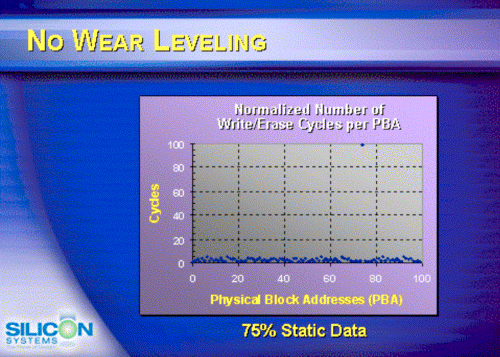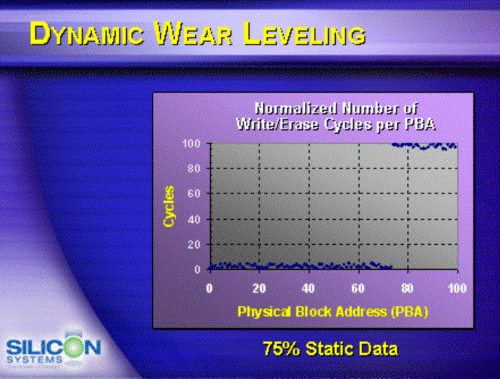Editor's intro:- Solid
state disks,
based on flash
technology, have greatly improved in performance in recent years and now
compete head to head with RAM
based accelerator systems. Flash also has significant advatanges in servers
compared to RAM SSDs
due to low power consumption. But if you think that all solid state disks which
use flash are equally reliable
and enduring
then think again.
That's a bit like saying that a Mercedes 300SL
sports coupe is as tough as a Tiger tank because both were made in Germany
and both are built out of metal. But as Oddball (Donald Sutherland) says in the
movie Kelly's Heroes "I ain't messing with no tigers."
This article by SiliconSystems, shows how their patented architecture cleverly
manages the wear out mechanisms inherent in all flash media to deliver a disk
lifetime that is about 4x greater than of other enterprise flash products and
upto 100x greater than intrinsic flash memory. |
| . |
Increasing Flash SSD Reliability
(this
classic article by
SiliconSystems
was published here in April 2005)
SiliconSystems' SiliconDrive
technology is specifically designed to meet the high performance, high
reliability and multi-year product lifecycle requirements of Enterprise System
OEMs in the netcom, military, industrial, interactive kiosk and medical markets.
One of the measures of storage reliability in Enterprise System OEM applications
is endurance. Endurance is defined as the number of write/erase cycles that can
be performed before the storage product "wears out."
It is important to note that endurance is not just a function of the
storage media. Rather, it is the combination of the storage media and the
controller technology that determines the endurance. For example, magnetic media
is an order of magnitude less reliable than NAND flash, yet the controller
technology employed by rotating hard drives can compensate for this deficiency.
{NOTE: This is just an example of how a
controller, if it is
well designed, can compensate for the deficiencies of the media. It is a
completely different discussion to compare the mechanical reliability of
rotating hard drives to solidstate storage that has no moving parts.}.
Write/erase cycle endurance for solid-state storage is specified in
many ways by many different vendors. Some specify the endurance at the physical
block level, while others specify at the logical block level. Still others
specify it at the card or drive level. Since endurance is also related to data
retention, endurance can be specified at a higher level if the data retention
specification is lower. For these reasons, it is often difficult to make an "apples
to apples" comparison of write/erase endurance by solely relying on these
numbers in a datasheet. A better way to judge endurance is to break the
specification down into the main components that affect the endurance
calculation
- Storage Media
- Wear-Leveling Algorithm
- Error Correction Capabilities
Other factors that affect endurance
include the amount of spare sectors available and whether or not the write is
done using a file system or direct logical block addressing. While these issues
can contribute to the overall endurance calculation, their effects on the
resulting number are much lower than the three parameters listed above. Each of
these factors will be examined individually, assuming ten-year data retention.
The final section of this white paper provides a calculator to assist
in the understanding effects of each of these parameters on the overall
endurance in an application.
Storage Media
The scope
of this white paper is confined to non-volatile storage – systems that do
not lose their data when the power is turned off. The dominant technology for
non-volatile solid-state storage is NAND flash. While NOR flash is also a
possible solution, implementation of NOR technology is generally confined to
cell phone and other chip-on-board applications. For these applications, NOR
provides execute-in-place, boot and data storage functionality in a single chip.
The economies of scale and component densities of NAND relative to NOR make NAND
the ideal solution for non-volatile solid-state storage systems.
The two dominant NAND technologies available today are SLC
(single-level cell, sometimes called binary) and MLC (multi-level cell). SLC
technology stores one bit per cell and MLC stores two bits. A comparison of SLC
and MLC is shown in Figure 1. |
 |
SLC NAND is generally specified at 100,000
write/erase cycles per block with 1-bit ECC (ECC is explained in greater detail
in this white paper). MLC is generally specified at 10,000 cycles with ECC.
While the datasheet for the MLC device does not specify the level of ECC
required, the MLC manufacturers recommend 4-bit ECC when using this technology.
Therefore, when using the same controller, a storage device using SLC will have
an endurance value roughly 10 times that of a similar MLC-based product. A
more thorough
discussion
of SLC versus MLC components can be found on the respective websites of
various NAND flash
component manufacturers on their respective websites.
Wear Leveling
Wear leveling allows data writes to be
evenly distributed over the storage media. More precisely, wear leveling is an
algorithm by which the controller in the storage device re-maps logical block
addresses to different physical block addresses in the solid-state memory array.
The frequency of this re-map, the algorithm to find the "least worn"
area to which to write and any data swapping capabilities are generally
considered proprietary intellectual property of the controller vendor.
It is important to note that wear leveling is done in the solid-state memory
controller and is independent of the host system. The host system performs its
reads and writes to logical block addresses only. So as far as the host
is concerned, the data does not move.
To illustrate the effects of wear leveling on overall endurance,
assume three different storage devices with the following characteristics:
- Flash Card with no wear leveling
- Flash Card with dynamic wear leveling
- SiliconDrive with static wear leveling
In addition, assume that
all three storage devices use the same solid-state storage technology (SLC or
MLC – for purposes of this discussion, it doesn't matter). All three
devices will have 75% of their capacity as static data, which is defined as any
data on a solid-state storage device that does not change. Examples of static
data include operating system files, look-up tables and executable files.
Finally, the same type of write is performed to all three systems. The
host system single block of data to the same logical block address over and over
again.
No Wear Leveling
Figure 2 (below) shows a normalized distribution of writes to a
flash card that does not use wear leveling. In this instance, the data gets
written to the same physical block. Once that physical block wears out and all
spare blocks are exhausted, the device ceases to operate, even though only a
small percentage of the card was used.
In this instance, the endurance
of the card is only dependent on the type of flash used and any error correction
capabilities in excess of one byte per sector. Early flash cards did not use
wear leveling and thus failed in write-intensive applications. For this reason,
flash cards with no wear leveling are not recommended for Enterprise System OEM
applications. |
 |
Dynamic Wear Leveling
Figure 3 (below) shows a normalized distribution of writes to a
flash card that employs dynamic wear leveling. This algorithm only wear levels
over "free" or "dynamic" data areas. That is to say, if
there is static data as defined above, this area is never involved in the wear
leveling process. In the current example, since 75% of the flash card is used
for static data, only 25% of the card is available for wear leveling. The
endurance of the card is calculated to be 25 times greater than the card with no
wear leveling, but only one-fourth that of static wear leveling. |
Dynamic Wear Leveling
Figure 3 (below) shows a normalized distribution of writes to a
flash card that employs dynamic wear leveling. This algorithm only wear levels
over "free" or "dynamic" data areas. That is to say, if
there is static data as defined above, this area is never involved in the wear
leveling process. In the current example, since 75% of the flash card is used
for static data, only 25% of the card is available for wear leveling. The
endurance of the card is calculated to be 25 times greater than the card with no
wear leveling, but only one-fourth that of static wear leveling. |
 |
Static Wear Leveling
Figure 4 (below) shows a normalized distribution of writes to a
SiliconDrive that employs static wear leveling. This algorithm evenly
distributes the data over the entire SiliconDrive. The algorithm searches for
the least-used physical blocks and writes the data to those locations. If these
locations are empty, the write occurs normally. If they contain static data, the
static data is moved to a more heavily-used location prior to the new data being
written. The endurance of the SiliconDrive is calculated to be 100 times
better than the card with no wear leveling and, in the example discussed
here, four times the endurance of the card that uses dynamic wear leveling. |
 |
Error Correction
Part of a
solid-state memory component specification is related to
error correction.
For example, SLC NAND components are specified at 100,000 write/erase
cycles with one-bit ECC. It goes to reason that the specification increases with
a better error correction algorithm. Most flash cards employ error correction
algorithms ranging from two-bit to four-bit correction. SiliconSystems'
SiliconDrive technology is based on the Company's industry-leading six-bit
correction.
The term six-bit correction may be slightly confusing. Six-bit
correction defines the capability of
correcting up to six bytes in a 512-byte sector. Since a byte is eight
bits, this really means the SiliconDrive can correct 48 bits as long as those
bits are confined to six bytes in the sector. The same definition holds true for
two-bit and four-bit correction.
The relationship between the number
of bytes per sector the controller can correct is not directly proportional to
the overall endurance, since the bit error rate of NAND flash is not linear. To
state it another way, six-bit error correction is more than three times better
than two-bit ECC since the probability of getting a three-bit error is
significantly greater than the probability of a seven-bit error.
Summary
of Media,, Wear Leveling and ECC
There is much confusion about the definition of "industrial
grade." Many companies are seeking to only define industrial grade in terms
of the solid-state memory components in the storage device – namely SLC vs.
MLC NAND. While this is an important issue, the capability of the controller to
compensate for the media is even more significant. Use of wear leveling and
error correction technologies can dramatically affect the reliability and
enhance the usable life of the storage device in an Enterprise System OEM
application.
The matrix below summarizes the effects of the different items
discussed throughout this white paper.
In the table (below), a "1"
indicates the best possible endurance scenario, and a "10"
indicates the least desirable configuration. Values 2-9 are a bit more
subjective, but their relative positioning makes sense in the context of most
types of data transfers.
N = No Wear Leveling; D = Dynamic Wear Leveling; S = Static Wear
Leveling |
 |
Wear leveling is important as it allows data
writes to be evenly distributed over the entire storage device. A device with no
wear leveling wears out faster because data is written to the same physical
block. Flash cards that use dynamic wear leveling algorithm only write across
dynamic or free data areas. By far the best endurance is provided by static wear
leveling, where the data is written equally to all blocks of the storage device.
Equally important is the error correction capability. Most flash cards
use error correction algorithms ranging from two-bit to four-bit correction.
Industrial grade solutions should in general use more robust algorithms.
SiliconSystems has designed an industry-leading six-bit error correction into
its entire product family of SiliconDrives.
SiliconSystems' SiliconDrive technology provides the optimum mix of
controller and storage component technology to maximize endurance. SiliconDrives
use the powerful combination of the most reliable solid-state memory components
currently available, static wear leveling and industry-leading six-bit ECC to
deliver highly reliable industrial-grade solid-state storage solutions for
Enterprise Systems OEMs.
Endurance Calculations
To
get an idea of how long a solid-state storage device will last in an
application, the following calculations can be used.
Note: These
calculations are valid only for products that use either dynamic or static wear
leveling. Use the solid-state memory component specifications for products that
do not use wear leveling. To calculate the expected life in years a product will
last: |
 |
| To calculate the number of data transactions: |
 |
| Here are some more
SSD articles
you may be interested to read
|
|

| |
 |
. |
|
|
. |
|
|
. |
|
As the complexity of flash has increased - with more layers and more bits
per cell TLC / OLC - it is becoming harder for designers to manually (or using
human expertise) guarantee they are choosing the optimum magic numbers for
write programming and voltage thresholds inside SSDs - because there are so
many variables involved.
|
| the background to
machine learned endurance tuning (July 2016) | | |
. |
 |
. |
 |
. |
...Later:-
in January 2006 - SiliconSystems published more information about how they were
engineering increased reliability into flash disks. Below is the text of their
press release.
SiliconSystems Introduces the Industry's First
Self-Monitoring Solid-State Drive
ALISO VIEJO, Calif., January 30, 2006 - SiliconSystems, Inc.
today announced a breakthrough storage system monitoring and usage technology
called SiSMART.
This new, patent-pending technology accurately
monitors storage system usage to predict useable life, and is incorporated into
the company's entire SiliconDrive product line. By monitoring read/write
activity, SiSMART technology provides users of solid-state storage systems a
level of confidence and accuracy about the viability of their storage solutions
previously unobtainable.
SiSMART technology constantly monitors and
reports the exact amount of storage system useable life available allowing users
to make any necessary adjustments or schedule preventative maintenance to ensure
system availability and data integrity. SiSMART technology is ideal for
enterprise system OEM applications in the netcom, military, industrial,
interactive kiosk and medical markets.
"Solid-state storage technology offers major benefits over
rotating disk drives, such as added security and unmatched ruggedness, but until
now there were valid concerns about the inability to accurately predict storage
system lifespan," said Michael Hajeck, CEO at SiliconSystems. "After
receiving overwhelmingly positive feedback from some of our most demanding
tier-one customers regarding the accuracy and dependability of our SiSMART
technology, we decided to include this breakthrough technology in our complete
line of SiliconDrive products."
Solid-state drive lifespan is becoming a topic of concern among
analysts, according to Gartner
Senior Analyst Joseph Unsworth. "There is a strong need in the market for
a means to track drive usage and make more accurate predictions concerning
lifespan. Technology that enables customers to have the ability to set their
own parameters and anticipate when problems will arise with their drives will be
attractive in order to manage risk."
Achieving What SMART Technology Cannot
Rotating hard
disk drives employ Self Monitoring and Reporting Technology (SMART), which
was designed to act as an early warning system for pending problems with
mechanical media. Though this technology is useful for monitoring wear on
rotating hard disk drives, it cannot be used to monitor the useful life of a
solid-state drive. Since solid-state storage products have no moving parts many
of the parameters monitored by the SMART function are not applicable.
Solid-state
storage components, which are the fundamental building blocks of every
solid-state drive, can lose the ability to retain programmed data after hundreds
of thousands to millions of write/erase cycles. With no method to determine or
predict when write/erase cycle endurance will be exceeded, a solid-state storage
product is typically allowed to operate until it ultimately fails, leading to
unscheduled system down times and significant data loss.
In contrast to SMART, SiSMART monitors how many write/erase cycles
have occurred on a solid-state storage system -- the only real failure mechanism
present in solid-state storage. By incorporating a patent-pending algorithm
that tracks all data transactions internally in the SiliconDrive, SiSMART is
able to accurately monitor and report storage system usage to the host system.
This enables users to model future usage, set thresholds to perform maintenance
and adjust data collection requirements to match the required life of the
deployed equipment.
Beginning in February 2006, SiliconSystems' entire SiliconDrive
product offering will come equipped with both SiSMART technology and the
company's patented PowerArmor technology. PowerArmor is another innovative
technology from SiliconSystems that was developed to eliminate storage system
field failures by virtually eliminating drive corruption and data loss in the
event of unexpected power disturbances. SiliconDrives equipped with SiSMART and
PowerArmor will provide a level of data integrity and data reliability never
previously available.
| |
. |
 |
. |
| "Inside the brain of
the SSD - a nerve ending tugs to say - forget your other priorities pal - the
power rail is going down. " |
| Surviving SSD
sudden power loss | | | |







